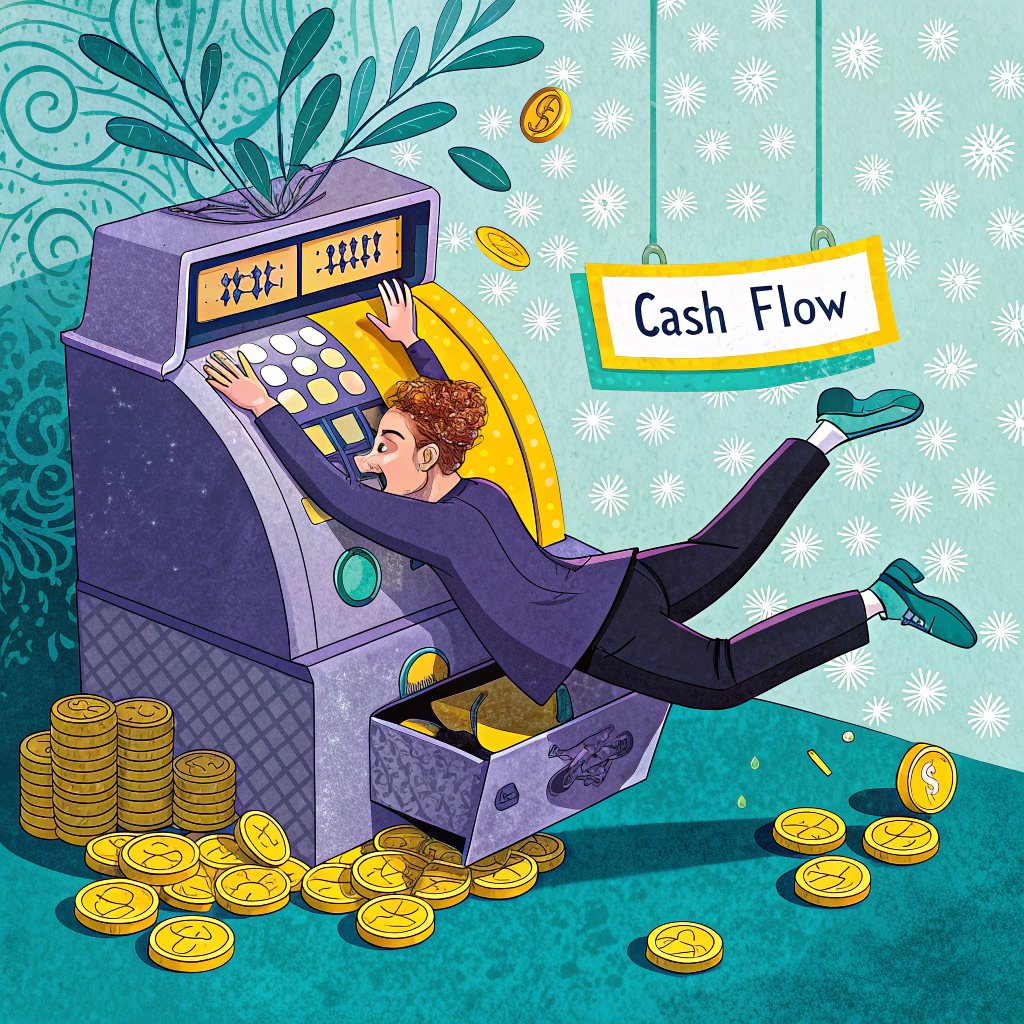What is This “Cash Ratio” Everyone’s Talking About?
Let’s cut to the chase: the cash ratio. What’s the big deal, and why should you care?
Imagine this scenario: All your bills are due today—yes, today. Can you pay them with the cash you have on hand right now? If you’re nervously checking your wallet, you’ve just stumbled upon the concept of the cash ratio.
Alright, time for a tiny bit of theory (don’t worry, we’ll keep it snappy):
The cash ratio is a type of liquidity ratio that measures your company’s ability to settle its short-term debts using cash and cash equivalents. Think of it as the ultimate financial stress test: can you cover all your IOUs with just the cash sitting in your bank account?
Cash is king—it’s the most liquid asset you’ve got (unlike accounts receivable and inventory, which can take weeks or even months to turn into cash). By comparing your cash to your financial liabilities, you understand what part of your debt can be covered right now.
It can take ages for accounts receivable and inventory to convert into cash (selling those 1,000 units of your revolutionary water-proof socks isn’t happening overnight), so creditors feel more comfortable lending to companies with better cash ratios.
But hold on! Even though creditors prefer a higher cash ratio, companies don’t usually keep it too high. A cash ratio greater than 1 suggests you’ve got more cash than you know what to do with. Sounds great, right? Well, we’ll dive into this dance around the magic number 1 in just a bit.
Decoding the Cash Ratio: Are You Drowning or Staying Afloat?
Understanding the Cash Ratio Formula: It’s Simpler Than You Think!
First things first, let’s peek at the formula (don’t worry, it’s not rocket science):
Cash Ratio = (Cash + Marketable Securities) / Current Liabilities
In plain English, it’s your cash-to-debt ratio.

Cash Ratio Greater Than 1: You’re Sitting Pretty… or Are You?
A cash ratio greater than 1 means your company has more cash and cash equivalents than current liabilities. In other words, you could pay off all your short-term debts and still have cash left over for that office foosball table.
Sounds awesome, right? Well, not so fast.
While a high cash ratio might make your creditors sleep better at night, it could also signal that you’re not putting your cash to good use. Instead of investing in profitable projects or fueling company growth, you’re letting your money gather dust. It’s like hoarding snacks but never eating them—wasteful and a bit sad.
Moreover, a high cash ratio might mean you’re worried about future profitability and are building a financial cushion. Sitting on a pile of cash because you’re scared isn’t exactly a winning strategy.
Cash Ratio Less Than 1: Don’t Panic! We’ve Got Strategies to Boost Your Liquidity
If your cash ratio is less than 1, it means you have more current liabilities than cash and cash equivalents. In simple terms, you don’t have enough cash on hand to settle all your short-term debts right now.
But don’t hit the panic button just yet. This isn’t necessarily a disaster. If you have favorable credit terms with suppliers, minimal credit extended to customers, and efficiently managed inventory, you might be just fine. It’s like juggling—but with practice, you won’t drop the balls.
Generally, a cash ratio less than 0.5 is considered risky because you have twice as many short-term liabilities compared to cash. It’s like walking a tightrope without a safety net.
What’s a “Good” Cash Ratio Anyway?
So, twice as many short-term liabilities compared to cash is risky, and having more cash than liabilities might be ineffective. What gives?
Here’s the kicker: There’s no one-size-fits-all answer. Cash ratios are all over the map depending on your industry. A ratio around 0.2 to 0.5 is often considered acceptable. It means you can cover 20% to 50% of your short-term bills with cash on hand.
If it’s lower than 0.2, you’re a bit short on readily available cash. But that doesn’t automatically spell doom. You’ll need to dig deeper into your short-term debt, interest rates, and whether you can use other assets to pay bills.
On the flip side, a cash ratio above 0.5 might suggest you’re not using your cash effectively. Instead of letting it sit idle, you could be investing in more profitable ventures. But maybe you’re just being cautious. Context is everything.

Industry Matters: There’s No Magic Number
The ideal cash ratio heavily depends on factors specific to your sector:
- Fast-growing companies: They often reinvest earnings into growth, leading to lower cash ratios.
- Capital-intensive businesses: Industries requiring significant upfront investment, like manufacturing, usually have lower ratios.
- Inventory turnover: Companies selling high-demand goods might operate safely with lower cash ratios.
- Economic climate: In shaky economies, businesses may keep higher cash reserves as a safety net.
- Payment cycles: If customers take forever to pay, you’ll need a higher cash ratio to cover gaps.
Instead of obsessing over one perfect number, consider:
- Industry averages: How does your cash ratio compare to others in your field?
- Competitor benchmarks: Are you ahead or behind your main competitors?
- Trends over time: Is your cash ratio improving or deteriorating?
A “good” cash ratio is relative. Don’t get hung up on a specific number. Focus on how your company stacks up in the real world.
Cash Ratio in Action: Real-World Examples for Every Entrepreneur
Let’s bring this to life with our friend Alice, the ceramics entrepreneur and proud owner of a cozy workshop. We met her earlier in “How Liquid Are We? Welcome to the Liquidity Ratio!”
Here’s a snapshot of her books:
Current Assets:
- Cash: $400
- Inventory (materials and ready-to-sell ceramics): $1,350
- Accounts Receivable (money owed to her): $550
Total Current Assets: $2,300
Current Liabilities:
- Bills to be paid: $250
- Accounts Payable (she owes suppliers): $600
- Short-term Debt: $250
Total Current Liabilities: $1,100
We suggested Alice decrease her inventory by selling some of her lovely ceramic trinkets and not ordering excess materials. If she sells half of her ceramics, her cash ratio jumps from 0.36 to 0.98.
Not bad! Alice is on the safe side, but is she being effective? Sure, it’s a comfortable, low-risk scenario, but raising the ratio to around 0.5 while managing inventory and accounts receivable would keep her balanced between being too risky and too passive.
In the startup world, maintaining a healthy cash ratio is critical for survival. Startups often face cash flow challenges due to high operational costs and limited revenue. A good cash ratio provides a buffer, ensuring the company can meet short-term obligations while scaling. Tech-savvy startup founders might overlook cash flow management in their focus on innovation—don’t be that person!
The Cash Ratio: Not a One-Size-Fits-All Solution
Why Relying Solely on the Cash Ratio Can Be Misleading
A healthy bank balance feels great—like you’re invincible. But fixating on that one number can give you a false sense of security, hiding issues that could sink your business.
Here’s why you need a broader perspective:
- Are you actually profitable? A fat bank account might just mean you haven’t spent much yet, not that you’re raking in dough. Look at profitability—are your sales covering costs and leaving room for growth?
- Are you using resources effectively? Sitting on cash without investing is wasting potential returns. Check your efficiency—are you getting the most out of your assets?
- What’s your debt situation? A big cash balance might hide high debt levels. Ignoring leverage can create future challenges. Understand your debt to plan better.
The bottom line? Don’t get stuck in a “cash ratio coma.” Get a complete financial checkup. Look at key metrics like profitability, efficiency, and leverage alongside your cash flow. It’s like having a team of financial advisors, each offering a vital perspective. This holistic approach helps you make smarter decisions, manage money better, and build a thriving business.
Beyond the Numbers: Practical Tips for Managing Your Cash Flow
Instead of reducing risks (and profitability) by maintaining a high cash ratio, consider optimizing your inventory and accounts receivable. Here’s how:
Optimize Inventory Management
- Forecast demand: Use data to predict what you’ll need and when.
- Get the right stuff to the right place at the right time: Streamline your supply chain.
- Minimize storage costs: Don’t pay to store what you don’t need.
- Avoid excess or waste materials: Keep inventory lean to free up cash.
Manage Accounts Receivable
- Evaluate new customers: Set credit limits based on risk assessments.
- Generate accurate and timely invoices: Don’t delay billing.
- Regularly review unpaid invoices: Stay on top of who owes you.
- Follow up on overdue payments: Don’t be shy—it’s your money.
- Offer discounts for early payments: Incentivize quick payouts.
It would also help to track key performance indicators like inventory turnover and accounts receivable turnover. These metrics can spotlight areas needing improvement.
You can work on managing current liabilities by negotiating better terms for your loans, if you have any. Every bit helps.
The Cash Ratio: Your Partner in Financial Success
The cash ratio is a tool—not a dictator. Use it wisely to make informed decisions about your business.
Remember: Maintaining healthy cash flow is an ongoing process, not a one-time fix. Stay vigilant, stay informed, and you’ll navigate the financial waters like a pro.
